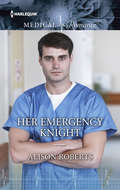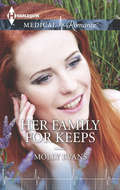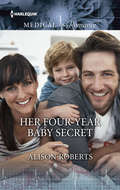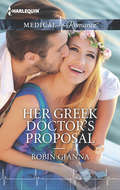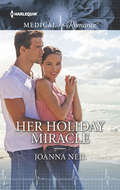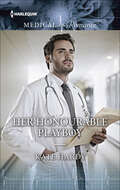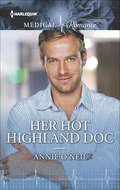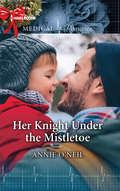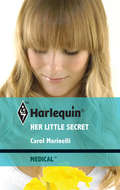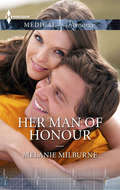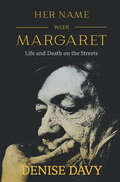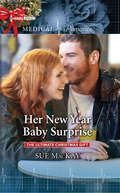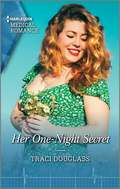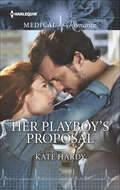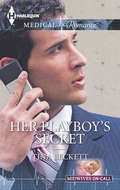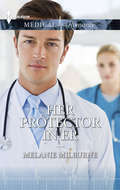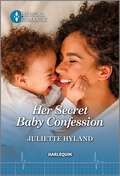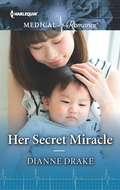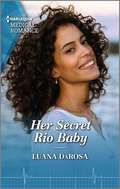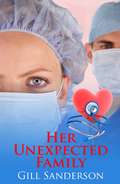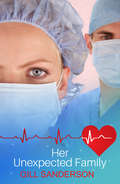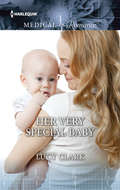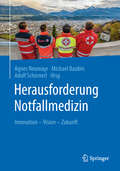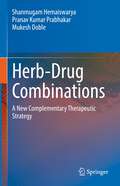- Table View
- List View
Her Emergency Knight
by Alison RobertsComing soon! Her Emergency Knight by Alison Roberts will be available Aug 15, 2016.
Her Family for Keeps
by Molly EvansRebel without a home! Being a traveling nurse suits Rebel Taylor just fine-no ties, no relationships, no dating! With the Huntington's gene in her family, what can she possibly offer a guy anyway? But Duncan McFee, Albuquerque's hottest and most single doc, disagrees. He's determined to tempt this stunning, wonderful woman-and when he does, her story is enough to make him risk his own heart. He can give her all the love and family she could want. All he needs to do is persuade Rebel!
Her Four-Year Baby Secret
by Alison RobertsA father for her son Single mom and paramedic Fiona Murchison will do anything to shield her little boy from the glare of the world's media. No one knows that her late husband, celebrity racing driver Al Stewart, has an heir, and Fiona is determined to keep it that way to keep her child safe... All is at risk, though, when a charming new surgeon arrives in Town, and Fi immediately recognizes him as Al's brother Nick! The time has come for Fi to confess her four-year-old secret. Nick is overjoyed to discover he has a nephew, and Fiona is relieved to know that Nick, too, will do anything to protect this little family from the world--including loving them as if they were his own.
Her Greek Doctor's Proposal
by Robin GiannaThe question he thought he'd never ask... Archaeologist Laurel Evans put her career on hold to care for her younger sisters. Now, close to achieving her goals, she won't let anything distract her. Laurel has come to Delphi to dig up ancient treasures, but she finds a modern-day Greek god instead-local doctor Andros Drakoulias! A devoted single dad, Andros is determined to give his little girl stability. He knows his fling with Laurel can't last, so why is it so hard to imagine a future without her by his side?
Her Holiday Miracle
by Joanna NeilHer Caribbean Escape Talented ER doc Cade Byfield appears to have it all, yet there's always been something missing. When Dr. Rebecca Flynn arrives on his Caribbean island, Cade begins to think that she might be the answer. But the mysterious beauty hides a devastating secret-the family Cade wants is the one thing she can never give him. Until one smoldering kiss in the eye of a storm makes Rebecca question: Could trusting Cade with her past give them both the future they dream of?
Her Honourable Playboy
by Kate HardyFrom E.R. doctor to high-society bride?Registrar Alyssa Ward is not pleased when she wins a date with the E.R. consultant, Honorable Sebastian Radley. She's not in the market for a relationship—especially not with a renowned womanizer like Seb. But, then again, he is devastatingly handsome—and, after all, it's only one date.Seb has never been one for monogamy. So why does he find that one date with Alyssa just isn't enough? There's so much more to her than just another woman he's dated. And when she gives him some life-changing news, he finds himself reassessing who he really wants to be—every woman's honorable playboy, or Alyssa's honorable husband?
Her Hot Highland Doc
by Annie O'NeilA match made in Scotland He might have the good looks of a modern-day Viking, but Dr. Brodie McClellan has brooding down to an art. He's only recently returned to the Isle of Dunregan and already the demons of his past are pushing him to the edge. Running from her own troubled past, this remote posting is heaven-sent for locum Dr. Kali O'Shea. And Brodie makes her long to find her true home in Scotland...in her new boss's arms!
Her Knight Under the Mistletoe: The Nurse's Special Delivery Her New Year Baby Surprise Her Knight Under The Mistletoe (Large Print Medical Romance Ser. #Vol. 928)
by Annie O'NeilAll the single mom wants for Christmas…London ER doctor Matthew Chase is shocked that his new role has become a job share with Dr. Amanda Wakehurst—the last woman he expected to see again.Matthew is also unaware he’s the father of her little boy, until Tristan is critically injured. Yet Matthew is there to support Amanda in her hour of need, and he proves how much he wants to be Tristan’s dad. Dare she hope he still wants her, too? Being together as a family this Christmas would be her ultimate gift…
Her Little Secret
by Carol MarinelliHer Little Secret Eastern Beach Hospital is just the next stop for doctor Nick Roberts hes left broken hearts on every continent! But Nicks funloving attitude is so infectious that his patients and nurse Alison Carter are unwillingly hooked. One night with Nick leaves Alison with a new zest for life and one rather more unexpected gift The Doctors Damsel in Distress Theres something about nurse Madison that has Dr Levi Fielding desperate to have her in his arms. Her girlnextdoor looks and unawakened sex appeal mean he cant resist flustering her! So when Levi saves Madisons life at a hospital picnic, he knows its a white knight moment he ll take full advantage of
Her Man of Honour
by Melanie MilburneTo love, honour and protectIt's Dr. Amy Tanner's first day in the beautiful coastal village of Marraburra. She's here to give her patients the best possible care, and also to uncover the truth behind her cousin's disappearance. Gorgeous sheriff Angus Ford is impressed with the new doctor's feisty courage and unquestionable skill--not to mention her stunning looks. But when Amy finds out the truth about her cousin, Sheriff Ford is determined to protect her.Amy's intention is to settle the past and then head back to her life in the city, but this commanding, caring man has changed her mind. Could her real home be in Marraburra, as the sheriff's wife?
Her Miracle Baby
by Fiona LoweAll she wanted was to give him a child…Surviving a plane crash in the alpine forests of Australia sparks the beginning of a real connection between Dr. Will Cameron and nurse Meg Watson. A connection they delight in strengthening when Will finds himself helping Meg in her understaffed outback nursing center.But Meg knows that she has no chance of a future with Will. He wants what she is unable to give him— children. Then after one passionate night together… a miracle happens….
Her Name Was Margaret: Life and Death on the Streets
by Denise DavyAt age eighteen, Margaret Jacobson was admitted to the Ontario Hospital, later renamed the Hamilton Psychiatric Hospital. Years later, she died homeless and alone in the city. With meticulous research and deep compassion Denise Davy has pieced together Margaret's story – from promising student to patient, to homeless woman, to an unmarked grave – and asks us to look hard at the system that buried her there.
Her New Year Baby Surprise
by Sue MacKayA new baby of her own?Nurse Emma Hayes was happy being a surrogate to give her best friend, Abbie, her baby. She has her own daughter, Rosie, and everything she needs. Until handsome ER doc Nixon Wright gets under her skin!Having lost his family young, Nixon is wary of falling in love. But there’s something about Emma… Soon he’s fallen under her spell, with very unexpected consequences!Nevertheless, Emma faces the New Year full of hope for the future. But will the new baby they’ve created together be enough to melt Nixon’s frozen heart?
Her One-Night Secret (First Response in Florida #2)
by Traci DouglassA return, a reunion……A shocking revelation!Firefighter Stacy Williams knows two things about her return to Key West. Her promotion gives her the security she needs to raise her son, and it will be almost impossible to suppress the memories of her passionate night with Dr. Luis Durand. Almost…until working on the hurricane response team brings an encounter with the tall, dark and nomadic doc! And the chance to make her life-changing confession…A First Response in Florida novelFirst Response in Florida duetBook 1 - The Vet&’s Unexpected HeroBook 2 – Her One-Night Secret&“Their Hot Hawaiian Fling by Traci Douglass is a fantastic romance.... I love this author's medical romance books and this is no exception. Both characters are well written, complex, flawed and well fleshed out. The story was perfectly paced. A great romance I highly recommend.&”-Goodreads&“A Weekend with Her Fake Fiancé gave me all the feels! I have come to love the Medical Romance books by this author and this one was so fantastic! The writing in this book is excellent with well fleshed out characters and a fun, passionate story line.&”-Goodreads
Her Playboy's Proposal
by Kate HardyTempted by the hospital heartbreaker! Nurse Isla McKenna is warned about Dr. Harry Gardiner the moment she enters the London Victoria's emergency department. He's a commitment-shy playboy-and Isla has been betrayed too often to play with fire! But there is more to this "bad boy" than meets the eye, and when Harry asks for help facing a family wedding, Isla can't refuse. Even if it means fighting the chemistry between them! Except their weekend together proves the ultimate temptation, leaving them both dangerously wanting much more...
Her Playboy's Secret
by Tina BeckettEveryone has a secret... Heartbreakingly handsome senior midwife Lucas Elliot manages to make any woman go weak at the knees! Only English obstetrician Darcie Green seems immune to his charms-his love-'em-and-leave-'em attitude infuriates her... But for Lucas, buttoned-up Darcie is the ultimate challenge-he's determined to bring out her wild side before she returns to England! Yet Lucas's plan backfires when he realizes he's dangerously close to falling for her... And, more worryingly, Darcie's even closer to discovering the secret behind the playboy!
Her Protector in ER
by Melanie MilburneThe doctor and the detective... Five unexpected deaths have brought hotshot city detective Liam Darcy to town. Dr. Keiva Truscott is first on Liam's list of suspects! But surely as he watches her save lives with compassion and courage she won't be under Liam's suspicion for long...?Although a relationship between them is strictly forbidden, a secret source has revealed that Liam is starting to fall under Keiva's spell. All Liam's instincts are telling him that Keiva is innocent, and he will do anything to protect her--but until the case is closed, Liam can't fall in love with his prime suspect.
Her Secret Baby Confession (Hope Hospital Surgeons)
by Juliette HylandA one-week fling…with binding consequences! Dive into this irresistible secret-baby romance from Juliette Hyland, the second installment in her Hope Hospital Surgeons duet. HER SECRET. THEIR FAMILY?Let me introduce you to your daughter are not words responsible surgeon Ryann ever thought she&’d say. Yet here she is, face-to-face with the man she spent one incredible, and totally out of character, week with, confessing she&’s had his baby! Despite growing up in the foster system, nurse anesthetist Jackson is thrilled to be a dad. But can they be more than co-parents when cautious Ryann so ardently protects her carefully curated life…?From Harlequin Medical: Life and love in the world of modern medicine.Hope Hospital Surgeons
Her Secret Miracle: Her Secret Miracle / From Midwife To Mummy (Mills And Boon Medical Ser. #Vol. 1037)
by Dianne DrakeCan their miracle baby……bind them — forever?Dr. Michi Sato will never forget the night of incredible passion she shared with lone-wolf billionaire and surgeon Eric Hart. Especially as it resulted in the baby she never thought she’d have. Her son’s heart condition has meant Michi’s always put him first, but now she must fly him to New York for treatment…and tell guarded bachelor Eric that he’s a father!“Overall, Ms. Drake has delivered a wonderful and very heartfelt read in this book where the chemistry between this couple was just as strong in the present as it was in the past; the romance was delightful and special because these two are meant to be….”— Harlequin Junkie on Second Chance with Her Army Doc“This is an emotional rollercoaster second-chance romance packed with drama…an enthralling, moving story. It has well developed characters…as well as a heart warming romance, a lovely read which I have no hesitation in recommending to anyone who, like me, enjoys this genre!”— Goodreads on Reunited with Her Army Doc
Her Secret Rio Baby
by Luana DaRosaWhen one night of passion in Rio de Janeiro leads to a life-changing consequence, find out what the surgeon does next in the latest Harlequin Medical Romance novel from Luana DaRosa.An impulsive night of passion…A life-changing consequence! The night surgeon Eliana Oliveira met Diego Ferrari, he was just a handsome stranger in a bar in Rio de Janeiro. And acting on their instant attraction was the perfect escape from the shock of inheriting a whole hospital from her estranged late father. Now, on her first day at Santa Valeria General, she&’s in for two shocking discoveries: first, coming face-to-face with Diego in the operating room, and second, that she&’s expecting his baby!From Harlequin Medical: Life and love in the world of modern medicine.
Her Unexpected Family
by Gill SandersonNurse Tessa Calvert loves her work and as she is a trained counsellor she also loves her part-time job as an 'agony aunt' on local radio. She is horrified when she is accused of giving foolish advice to an awkward teenage girl - especially when she discovers that the girl is Lucy Armstrong - the daughter of James Armstrong , her new boss in A and E. Tessa manages to becomes friends with Lucy and to help her, much to the delight of James. He admires Tessa for her professional skills - but also feels a growing attraction to her. She feels the same way. However, when Lucy falls seriously ill, Tessa is persuaded that the best thing to do would be to leave her job and leave James. He finds her, convinces her that she is wrong.
Her Unexpected Family: A Captivating Medical Romance (Medical Romances #9)
by Gill SandersonAnother heartwarming medical romance from best-selling author Gill Sanderson! Perfect for fans of Mia Faye, Laura Scott, Helen Scott Taylor, Grey's Anatomy and ER.Readers LOVE Gill's delightful medical romances!'A gripping tale, a romantic tale' 5* reader review'A truly wonderful writer' 5* author review 'I find all of Gill Sanderson's books very readable and enjoy the escapism they give me' 5* author review Nurse Tessa Calvert loves her work and as she is a trained counsellor she also loves her part-time job as an 'agony aunt' on local radio. She is horrified when she is accused of giving foolish advice to an awkward teenage girl - especially when she discovers that the girl is Lucy Armstrong - the daughter of James Armstrong, her new boss in A and E.Tessa manages to becomes friends with Lucy and to help her, much to the delight of James. He admires Tessa for her professional skills - but also feels a growing attraction to her. She feels the same way. However, when Lucy falls seriously ill, Tessa is persuaded that the best thing to do would be to leave her job and leave James. Can he convince her that she is wrong?Don't miss Gill Sanderson's enthralling medical romances, including the A Lakeland Practice and the Good, Bad and Ugly series.
Her Very Special Baby
by Lucy ClarkThe baby he needs His skill, charm and caring nature make gorgeous doctor Nathan Young a wonderful addition to the practice. He lavishes attention on his patients, but after the loss of his wife and newborn child he can't face treating young children--preferring instead to leave that to his colleague, beautiful single mum Morena Camden. Morena can see that the memory of his family is affecting him both professionally and personally, and she desperately wants Nathan to overcome his hurt. Perhaps having Morena and her adorable son by his side could be just what Nathan needs...
Herausforderung Notfallmedizin: Innovation - Vision - Zukunft
by Agnes Neumayr Adolf Schinnerl Michael BaubinDas Buch bringt gesellschaftspolitische Fragen rund um die präklinische Notfallmedizin kritisch zur Sprache und diskutiert Maßnahmen, wie eine Neustrukturierung mit innovativen Versorgungskonzepten gelingen kann. Dabei stellt es sich den Fragen der Zukunft und entwirft interessante Lösungsansätze. Um zukünftigen Anforderungen gerecht zu werden, wird die Neustrukturierung der Notfallmedizin mit innovativen Versorgungskonzepten unabdingbar. Denn Rettungsdienst und präklinische Notfallmedizin stehen im Wandel: Der politische Kostendruck steigt, die Freiwilligenarbeit gelangt an ihre Grenzen. Historisch gewachsene, meist lokal-strukturierte Organisationsformen konkurrieren mit privatwirtschaftlich orientierten Unternehmensstrategien. Den neuen Herausforderungen wie der Zunahme an älteren, multimorbiden Personen oder jener von Amokläufen steht der drohende Notärztemangel gegenüber. Es richtet sich an Führungskräfte im Rettungs- und Notarztwesen Notärzte, politische Entscheidungsträger, Krankenhaus- und Sozialversicherungsträger.
Herb-Drug Combinations: A New Complementary Therapeutic Strategy
by Mukesh Doble Shanmugam Hemaiswarya Pranav Kumar PrabhakarPlant extracts or their pure natural constituents have been used traditionally for thousands of years for treating diseases with considerable success in India and other Asian countries. In addition, they have also been used as complements or supplements with conventional medicine. This book discusses the latest research in the application of combination therapy, namely herbs and drugs, in the treatment of a range of communicable and non-communicable diseases to achieve a synergistic effect. This synergy may help in reducing the amount of drug, its toxicity, side effects, and development of resistance as well as improve its efficacy. The book also discusses the pharmacodynamic and pharmacokinetic parameters, experimental tools to determine the impact of combination, computational approaches to identify synergy, statistical analysis of data, and clinical and regulatory issues. The book is useful for researchers in the fields of pharmacology, pharmacy and medicinal chemistry and those working in pharmaceutical and nutraceutical industries. This book could open up new strategies to focus on multiple targets to combat complex diseases unlike the single targeted drugs that are being currently marketed by the pharmaceuticals industries.
